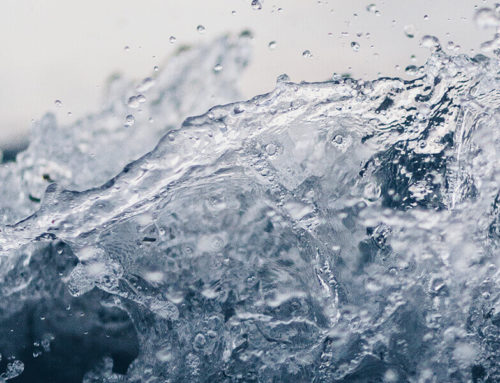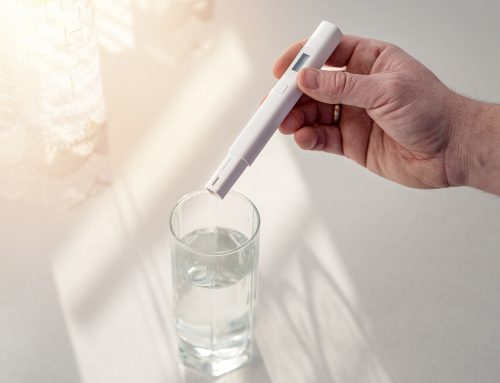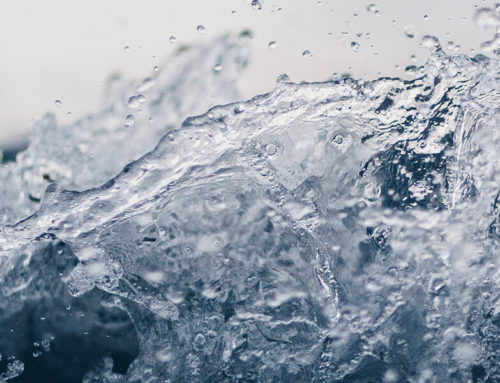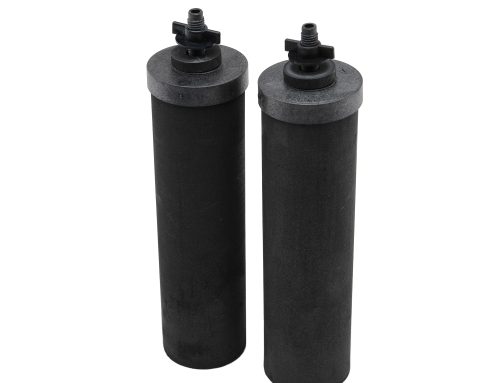The EPA recently reported that drinking water supplies to more than 5.2 million Americans are contaminated with a group of toxic chemicals known as Perfluorinated Chemicals (PFCs); at levels higher than what the EPA deems to be safe for human consumption.(1)
At Berkey® Water Systems, we want to help you understand critical information about PFCs, and show you how Black Berkey® Elements can help to safeguard your family’s drinking water.
What Are PFCs? What is PFOA?
PFC is the name given to a large family of chemicals called perfluorinated chemicals. PFOA is a long-chain type of PFC.
- All PFCs are man-made; they do not occur naturally in the environment.
- All PFC molecules are composed of carbon to which fluorine atoms are bound; their molecular structure gives them a slippery quality and the ability to repel other substances.
- The difference between one PFC and another is determined primarily by chain length, or the number of carbon atoms in its chemical makeup. There are two main groups of PFCs, long-chain and short chain.
- Longer chain PFCs such as PFOA and PFOS contains eight or more carbon atoms are more persistent in the environment and their health effects are well known. Shorter chain PFCs contain 7 or less carbon atoms, have proven to be less persistent, but their toxicity and effects have not been as thoroughly researched.
- The two most extensively produced and studied long-chain PFCs are PFOA and PFOS and are considered persistent organic pollutants. This means they:
- are extremely chemically and biologically stable
- remain in the environment and in the human body, for long periods of times
- are extremely resistant to breakdown when exposed to air, water or sunlight, acid or other forces
- can travel long distances from their point of origin
Bottom Line: PFCs are not like other toxins. They have been identified as some of the most persistent synthetic chemicals.
Where are PFCs Found?
Because of their unique chemical composition and ability to resist heat, water, dirt, grease and stains, PFCs are found in a vast array of consumer and industrial products.
They are incorporated into cookware to make it non-stick; carpets and sofas to make them more resistant to stains; mattresses, clothing and shoes to make them more waterproof; food packaging to prevent it from sticking to food, and some firefighting materials. Since they can reduce friction, PFCs are also used in a variety of industries, including aerospace, automotive, building and construction and electronics.
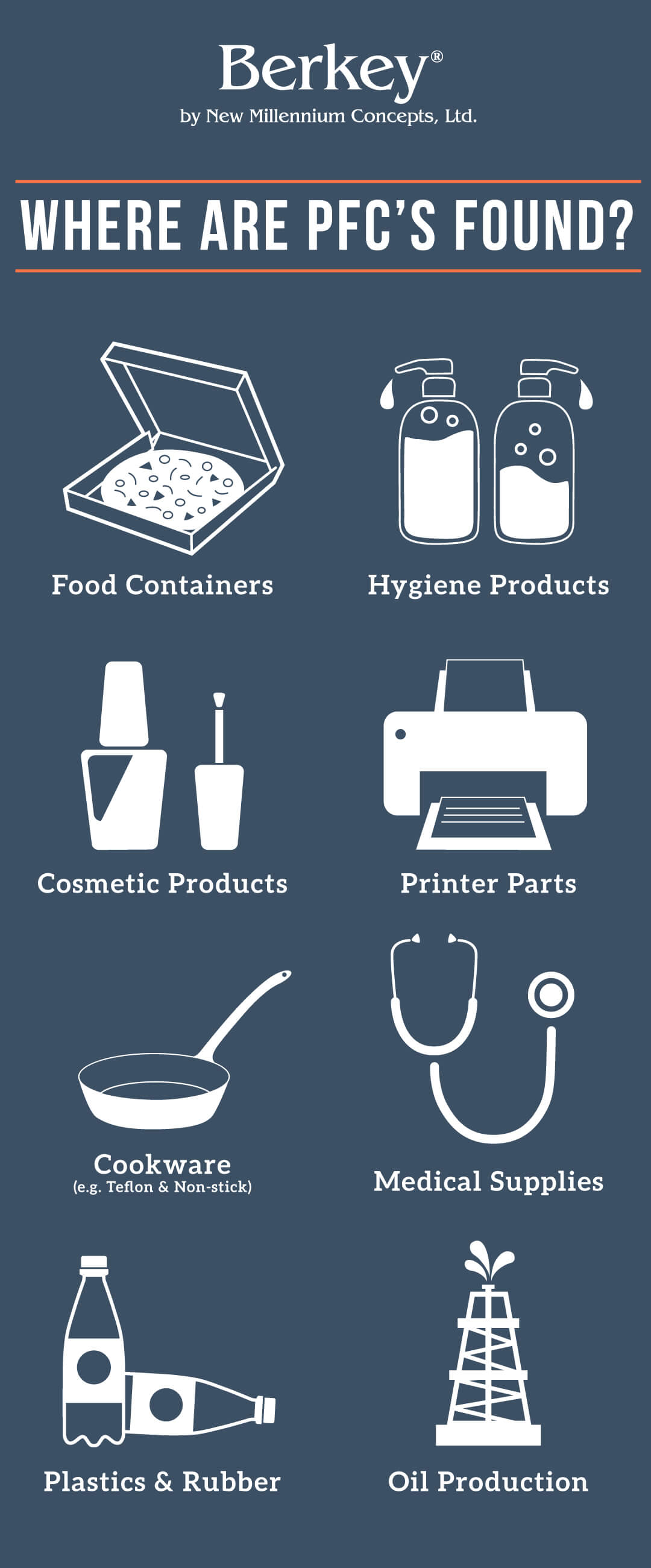
Consumer Products with PFCs:
- Cookware (e.g. Teflon™, Nonstick)
- Food Containers or package such as French fry boxes, pizza boxes, hamburger wrappers, and microwave popcorn bags
- Personal care products (e.g. shampoo, dental floss)
- Cosmetics (e.g. nail polish, eye makeup)
- Paints and varnishes
- Stain‐resistant chemicals (e.g. Scotchgard™)
- Water‐resistant apparel (e.g. Gore‐Tex®)
- Cleaning products
- Electronics
Industrial Uses for PFCs:
- Engineering coatings
- Medical devices
- Fire‐fighting foam for oil and gasoline fires
- Insect baits
- Printer and copy machine parts
- Oil production
- Textiles, upholstery, apparel and carpets
- Paper and packaging
- Rubber and plastics
Bottom Line: People can be exposed to PFCs by ingesting them; by drinking contaminated water or eating contaminated food.
What are the Health Effects of PFCs?
When we consume food or water that contains PFCs, it is easily absorbed, begins to accumulate in the body and the levels decrease very slowly over time. Continued exposure to PFCs increases this level, resulting in potentially adverse health effects. Studies in humans have shown that certain PFCs may be associated with(2)
- developmental delays in the fetus and child, including possible changes in growth, learning, and behavior
- decreased fertility and changes to the body’s natural hormones
- pregnancy-induced hypertension and preeclampsia
- increased cholesterol
- changes to the immune system
- increased uric acid levels
- liver tissue damage
- prostate, kidney, and testicular cancer
Bottom Line: Exposures to PFCs are known to have a number of adverse effects in laboratory animals and humans (EPA citation).

How are People Exposed to PFCs?
Since PFCs do not occur in nature, our main sources of exposure are from manufacturing, disposal and use of products containing the contaminant.
- Large amounts of PFCs have been produced in manufacturing processes and released in the air, soil and drinking water.
- Higher levels of PFCs can be found near areas where they are manufactured or where products containing PFCs are often used.
- PFCs can travel long distances, move through soil, seep into groundwater, or be carried through air. Once they get into groundwater, they persist there for a long time.
- PFCs can be found in public water systems, drinking water wells, surface water (lakes and ponds)
- Runoff from areas where water-based fire-fighting foam is often used, such as military or civilian airfields.
According to the centers for Disease Control, PFCs can now be found in trace amounts in the blood of roughly 98% of Americans, showing the widespread exposure to these PFCs in the U.S. population.(3)
Bottom line: PFCs can enter your bloodstream through the air you breathe, through your diet, through your use of nonstick products and other PFC–laden items, or by drinking tainted water.

Are PFCs Still Being Used?
In 2002, the largest United States manufacturer of PFOA (DuPont) voluntarily halted production of the chemical.(4) In 2006, eight leading manufacturers of PFCs voluntarily agreed to phase out their production of these chemicals by 2015, a key ingredient in making Teflon.(5)
Short-chain PFCs are still being produced worldwide; unfortunately, scientists say there is little evidence that these replacement chemicals are any safer.(6)
How Can I Avoid PFCs in Products?
Several organizations offer guidelines on reducing exposure to PFCs in everyday products. These guidelines include:
- Avoiding products labeled non-stick, waterproof, stain or water resistant
- Limiting fast-food paper food packaging
- Reading labels on personal care products to avoid PTFE or Perfluoro Ingredients
For more information visit the Environmental Working Group’s guide to avoiding PFCs in everyday products.
Are PFCs in My Water?
Want to find out if the testing found PFCs in your drinking water? The Environmental Working Group offers an interactive PFC Contamination Map that shows every U.S. county where the chemicals were detected. Click on your county to see if your water utility found any.
What is a Safe Level of PFCs in Drinking Water?
The two most problematic PFCs are PFOA, (previously used to make Teflon™) and PFOS (an ingredient in Scotchgard™). In May, 2016, the EPA announced a new Lifetime Health Advisory Level (HAL) for PFOA and PFOS individually or combined) to 70 parts per trillion. In simple terms, this is the equivalent of about a drop of water in 20 Olympic-sized swimming pools. This level is far more stringent than the previous EPA established level of 400,000 parts per trillion for PFOA and 200,000 parts per trillion for PFOS. (7)
These health advisory levels identify the concentration of PFCs in drinking water at which harmful health effects are not expected to occur if a person consumes them in water over a certain timeframe. The EPA recommends that if a person’s drinking water contains levels of PFOA or PFOS above 70 parts per trillion, they should not consume the water or use it in preparing food.
These health advisories are non-enforceable and non-regulatory and provide technical guidance to state agencies and other public health officials on assessing the contamination, informing the public and limiting exposure.
New Millennium Concepts Extreme Test
Your best protection against PFCs is to have a water filtration system that is rigorously tested to remove PFCs to below detectable levels. Not all water filter systems have been tested to the extreme level that Berkey® Water Systems have.
View the PFC Removal Extreme Test Results

What These Tests Results Mean
Berkey® Water Systems contracted an independent lab to set the pre-filtered water concentration of PFCs to one part per billion – a level far exceeding those recently established by the EPA. The test results above clearly demonstrate that the Black Berkey® Elements remove PFCs in water, down to the Extreme level of >99.9% at .002 micrograms per liter or two parts per trillion. That is the equivalent of one ounce in 7.5 billion gallons of water, or 1 square inch in 250 square miles.

References
(1) EPA.gov: Third Unregulated Contaminant Monitoring Rule
(2) EPA.gov: Basic Information about Per- and Polyfluoroalkyl Substances (PFASs)
(3) CDC.gov: Perfluorochemicals (PFCs) Factsheet
(4) EPA.gov: Basic Information about Per- and Polyfluoroalkyl Substances (PFASs)
(5) EPA.gov: Basic Information about Per- and Polyfluoroalkyl Substances (PFASs)
(6) Green Science Policy Institute: Madrid Statement
(7) EPA.gov: Provisional Health Advisories for Perfluorooctanoic Acid (PFOA) and Perfluorooctane Sulfonate (PFOS)
Resources
http://www.ewg.org/enviroblog/2015/08/your-drinking-water-safe
https://www3.epa.gov/
http://greensciencepolicy.org/



